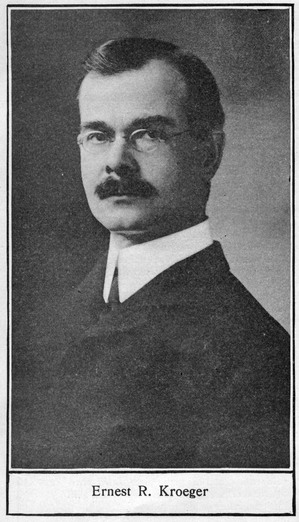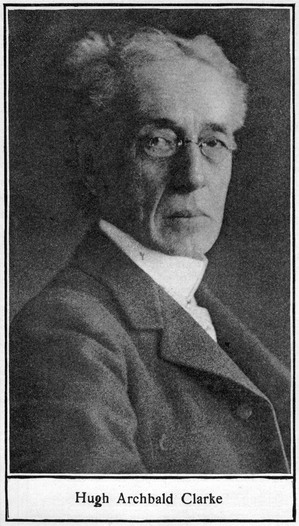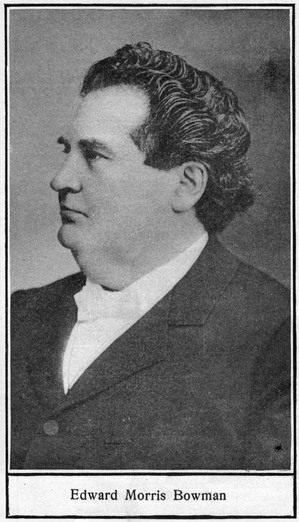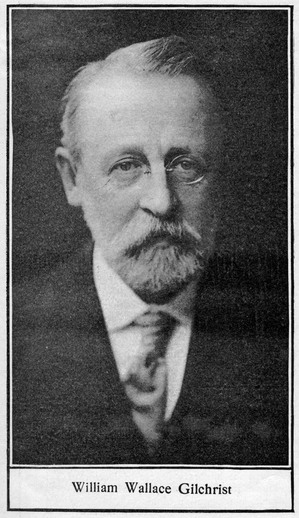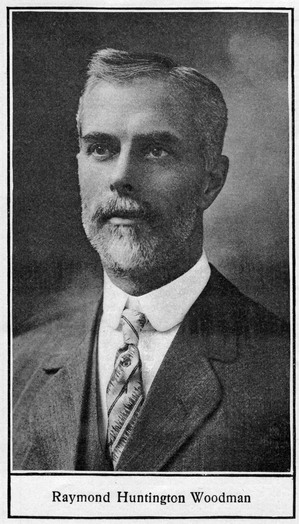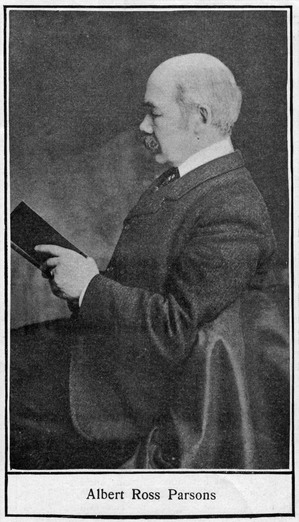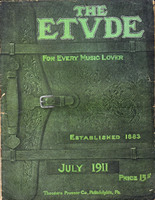The Story Of The Gallery
In February, 1909, THE ETUDE commenced the first of this series of portrait-biographies. The idea, which met with immediate and enormous appreciation, was an original project created in THE ETUDE offices and is entirely unlike any previous journalistic invention. The biographies have been written by Mr. A. S. Garbett, and the plan of cutting out the pictures and mounting them in books has been followed by thousands of delighted students and teachers. One hundred and eighty portrait-biographies have already been published. In several cases these have provided readers with information which cannot be obtained in even so voluminous a work as the Grove Dictionary. The first series of seventy-two are obtainable in book form. The Gallery will be continued as long as practical.
Mr. Kroeger was born at St. Louis, Mo., August 10, 1862. His father was a native of Germany and his mother English. Until the age of twenty-three music was a secondary consideration, though he received a good grounding. All his studies have been conducted in America, especially in the West, and he has chiefly been engaged in teaching in his home city. For some time he was director of the College of Music at the Forest Park University for Women. His keen interest in all that concerns the welfare of the music teacher and student is shown in the articles which he has contributed to The Etude and to other magazines from time to time. Mr. Kroeger was president of the Music Teachers’ National Association, 1895-6, and of the Missouri State Music Teachers’ Association, 1897-9. Like most American concert pianists, Mr. Kroeger has added to his musical usefulness by organ playing, and is a Fellow of the American Guild of Organists. As a conductor and composer, he has done some excellent work. He was Master of Programs in the Bureau of Music at the St. Louis Exposition of 1904. His compositions include a symphony, a symphonic poem, Sardanapalus an overture, Hiawatha—based on Indian themes, Ten American Sketches, and an overture inspired by Keat’s Endymion. He has written also a good deal of chamber music and pieces in smaller forms. His pipe organ piece, Adoration, and his piano piece, Little Masqueraders, are good examples of his skill in composing salon music.
Dr. Clarke was born near Toronto, Canada, August 15, 1839, and is the son of James Patton C. Clarke, Mus.Doc. (Oxford), a well-known organist and professor of music at the University of Upper Canada. Dr. Hugh Clarke played the organ in church when he was twelve years old. He moved to Philadelphia in 1859, and for twenty-two years was organist at the Second Presbyterian Church. In 1875 he was appointed professor of music at the University of Pennsylvania. He still occupies this position, and has exerted a wide and beneficial influence throughout his long career. His compositions include an oratorio, Jerusalem; but perhaps his best work in this direction is the music to Aristophanes’ Acharnians (for which he received the honorary degree of Mus.Doc. from Pennsylvania University) and the music to Euripides’ Iphegenia in Tauris. He also has a number of works in all forms in manuscript. He is inclined to regard his pupils as his “best works,” however, and both at the University and for twenty-four years at the Broad Street Conservatory he has done incalculable work for music. His text-books on harmony and counterpoint are very popular among all students of these subjects in America, and are works in which Dr. Clarke’s ripe scholarship and long experience as a teacher of theory have found admirable scope. He has also compiled a pronouncing dictionary and contributed articles to the standard musical magazines.
Mr. Bowman was born at Barnard, Vt., July 18, 1848. He first studied music in a somewhat desultory fashion, but the influence of Dr. William Mason altered all that, and he went through a long and thorough course of study in theory, piano and organ playing, etc. His teachers in America were Dr. Mason (piano) and John P. Morgan (organ and composition). In Germany he studied with Bendel, Rohde, Haupt and Weitzmann; in Paris with Batiste and Guilmant; in London with Macfarren, Bridge and Dr. Turpin. He was actively engaged in organ playing, conducting, teaching, etc., in St. Louis from 1867 to 1887. He then came to Newark, N. J., as organist of the Peddie Memorial Church until 1894. He has held many similar positions in the neighborhood of New York since then. He was one of the founders of the American Guild of Organists, re-organized and directed the Temple choir and orchestra, was professor of music at Vassar from 1891 to 1895, and has acted as conductor and organiser in many successful lines of musical work. As a writer, Mr. Bowman has had much of value to say. The Letters from a Musician to His Nephew now appearing serially in The Etude are excellent examples of his work. He has also translated the book on Harmony by his former teacher, Weitzmann. Altogether, Mr. Bowman may be taken as representing all that is best in American musical pedagogy.
Dr. Gilchrist was born at Jersey City, N. J., January 8, 1846. He studied with Dr. Clarke at the University of Pennsylvania and became nationally known as a singer. He was soloist at Holy Trinity Church during the Phillips Brooks regime. After a short time spent in Cincinnati, he returned to Philadelphia in 1873 and took up work as an oratorio singer, etc., and also as choirmaster and conductor of numerous choral organisations. In 1884 he organised two highly successful choral festivals with a chorus of 600 picked voices. At about this time he was choir director at St. Clement’s P. E. Church and also a teacher at the Philadelphia Musical Academy. He is the founder of the Mendelssohn Club, and for thirty-five years has been its conductor. His setting of the Forty-sixth Psalm won a $1,000 prize offered by the Cincinnati Festival Association in 1884, and many other prizes have fallen to his lot. His orchestral works include two symphonies and much chamber music of great worth. His choral works include a setting of the Ninetieth Psalm, Christmas Idyl, Easter Idyl, Prayer and Praise, and The Lamb of God, besides many anthems, part-songs, etc. The Syrens is typical of some excellent women’s choruses, and his songs include such popular favorites as Heart’s Delight, My Sins! My Sins! My Saviour! My Highland Lassie, and Oh Wert Thou in the Cauld, Cauld Blast. In 1895 he received the honorary degree of Doctor of Music from the University of Pennsylvania in recognition of his valuable services to music.
Mr. Woodman was born at Brooklyn, N. Y., January 18, 1861. He first began his career as an organist at St. George’s Church, Flushing, L. I., where in his thirteenth year he assisted his father. When eighteen years old he went to Christ Church, Norwich, Conn., for one year, after which he was appointed to his present post at the First Presbyterian Church, Brooklyn. He has brought the music of this church to a pitch of excellence perhaps unexcelled by any other in the country. He studied four years with Dudley Buck, and in 1888 received supplementary instruction from César Franck in Paris. Mr. Woodman is professor of music at the Packer Collegiate Institute, President of the Musical Department and a charter member of the Brooklyn Institute, an excellent private teacher, and director of the Theory Department at the American Institute of Applied Music. He has acted as Warden of the American Guild of Organists, of which he was one of the founders. As a composer Mr. Woodman has been especially successful in the smaller forms, many of his songs, such as A Birthday, An Open Secret, and The Pine, being typical of his marked ability. There are also many excellent anthems of his besides cantatas and part-songs. He has also contributed articles to various musical magazines, and from 1894 to 1897 he was editor of The New York Evangelist. Mr. Woodman’s work as a teacher and organist and composer is typical of what is best in modern practical musicianship.
Mr. Parsons was born at Sandusky, O., September 16, 1847. He studied piano with Robert Denton, of Buffalo, N. Y., at the age of six and first played in concert at eight. Removing to Indianapolis, Ind., in 1857, he studied alone till 1863, at the same time playing in concerts in different parts of the State. From his twelfth to his sixteenth year he played, self-taught, a two-manual organ in church. He studied harmony and composition with Dr. Ritter in New York, 1863-66, and then went to Europe. From 1867 to 1869 he studied with Moscheles, Papperitz, Wenzel and Reinecke at Leipsic. During 1872-73 he studied with Tausig, Weitzman and Kullak at Berlin, also receiving attentions from Wagner, Liszt, Rubinstein and von Bülow. On returning to New York in 1874 he became known as a pianist, teacher and organist. He conducted an enthusiastic Wagner propaganda, and was instrumental in having Wagner opera established at the Metropolitan. He has been closely identified with the Music Teachers’ Associations, and in 1889 was President of the National Music Teachers’ Association. He has composed pieces in smaller forms, of which an excellent specimen will be found in this issue, and has also edited technical and pedagogical works. He has also contributed to the literature of music. As a teacher he is equipped with an experience equalled by few in America, and Mr. Parsons has launched many successful musicians and music teachers upon the sea of life.


